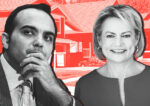Trending
Breaching the divide
More agents working in both sectors to drive deals
New York City real estate historically upheld a sacrosanct division — call it “church and state” — that separated residential and commercial brokerage. But these days, that divide is quickly eroding as brokers increasingly do business in both worlds.
Despite the traditional gulf between the industry sectors, there has been a convergence recently.
As prices for residential real estate soar, brokers are scrambling to create inventory anywhere they can. Not only do many agents team up with a counterpart on the other side, but some are also double-dipping, brokering sales of investment properties, private residences, and even retail space simultaneously.
Another factor driving the trend: Buyers increasingly have access to the same information that brokers do, making it more important for agents to bring something unique to the table.
“StreetEasy has been the great equalizer,” said James Nelson, a commercial broker with brokerage Massey Knakal, who specializes in building sales. But the West Village specialist now also brokers sales for single-family townhouses, like 146 Waverly Place, which recently went for $10.2 million.
That’s partly because there is less need to refer business to someone else if you can find a buyer yourself — a reality that StreetEasy has helped engineer by creating a listing platform that members of the public and industry professionals can access. While in the past residential brokers were required to be members of the Real Estate Board of New York to access listings databases, StreetEasy allows all brokers, and other users, to get the same data for $10 a month.
But it’s not just better information that’s driving the change. Transactions have also become increasingly complex, with facets of a residential transaction, such as air rights or “loft law” considerations, giving commercial brokers an edge. As a result, sellers are increasingly tapping commercial brokers to sell residential spaces, and some residential brokers are seeking partnerships with commercial brokers, sources told TRD.
Many properties, like 124 West Houston Street, which Eastern Consolidated’s David Schechtman and Warburg Realty’s Gordon Roberts listed together in October, present zoning “opportunities,” Schechtman said. The massive, 16,000-square-foot residence was being converted from multi-family into a single-family home, in a landmarked district. The nuances of a property like this require both a commercial and a residential expert, he said.
Nelson pointed to a townhouse at 164 Perry Street that was on the market three years ago, asking $3 million. “We realized there was value in the air rights,” he said.
He nabbed the listing after telling the owner that it was worth more like $4.5 million. In the end, the air rights were sold to the owner of an adjacent building for $1.5 million, he said, and the building itself fetched $3.4 million.
Creative solutions
In addition, both potential homeowners and investors have had to broaden their scope in terms of what properties they want to buy, said Robert Dankner, a broker with Prime Manhattan Residential.
“When inventory is so tight, you have to be a little more ingenious about what you do to take care of a client’s interest,” he said. And the lack of residential inventory lends itself to creativity, with brokers looking to carve new residential spaces out of commercial areas.
“I developed an investment-oriented business by accident,” said Dankner, noting that he finds sites with a “commercial entry and residential exit.”
For example, at 60 Beach Street, a Tribeca mixed-use building protected by the loft law, Dankner tapped his commercial skill set to help the new owner, HFZ Capital, do a workout on the distressed property. The property was partially converted to residential units and partially sold to a private equity group, according to HFZ founder Ziel Feldman.
Broader business
Some brokers have even found themselves drawn into retail brokerage from the residential side. For instance, Joe Robinson at Bond New York sold the owner of the popular German restaurant Wechsler’s Currywurst in the East Village his co-op at 136 East 51st Street a couple years ago.
“He mentioned he wanted to open a restaurant and asked if I could help,” Robinson said. “My first reaction was ‘no.’ ” But Robinson held his tongue and ended up helping his client locate the spot for Wechsler’s Currywurst. As a result, he formally expanded his business into retail, which he says is far more taxing than residential brokerage.
“It’s a painstakingly long process,” to rent out retail spaces, he said. But it’s helpful to have a broader business — a lesson he and many brokers learned during the lean times in 2009 and 2010.
While some brokers are simply expanding their repertoire to include the other side, others are incorporating brokers with other specialties into their team. Town Residential has made a name as a firm where residential brokers can dip into commercial listings, and agents and brokers can form novel teams for transactions that involve multiple uses.
Tom Brady and Martin Newman of Town work together, with Brady often selling a multi-family investment property that Newman then fills with tenants. They hooked up because they realized that they could miss out on listings if they didn’t broaden their scope.
For example, Martin represented the seller of 133 Mulberry Street, a commercial property. The seller later tapped Newman to rent out units at some of his other buildings, 116 and 118 Macdougal Street. They credit a collaborative environment at Town for helping them set up their successful partnership.
“For us, team work is [needed] because of the sheer volume” it creates, said Newman.
“Exactly,” echoed Brady. “I’d be missing out,” without the cross-pollination the partnership provides, he said.
Together, they have been able to cull enough business to stay more than afloat.
“Listings beget listings,” Brady said. “Of whatever type.”




